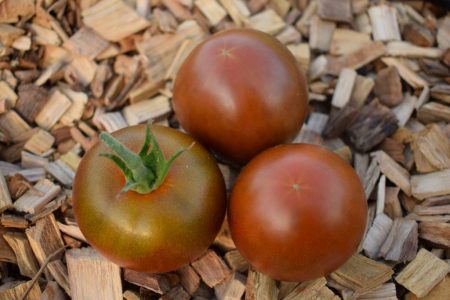
Tomatoes with unusual dark fruits are increasingly seen in areas of Russian gardeners. They are valued for excellent yield indicators and very good taste, but often do not know that such tomatoes are also very healthy. Among such exotics is the Brazilian Miracle variety, bred in distant Canada and successfully grown now in various countries.
Content
Grade description
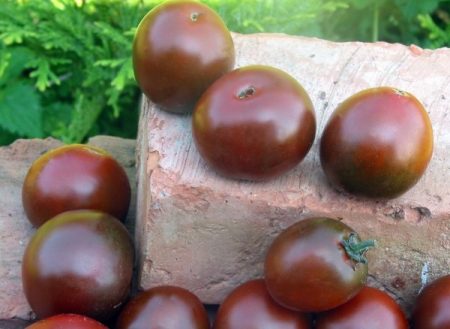
This tomato is considered rare, seeds cannot be found in specialized stores, and the only option is to purchase seeds from collectors. Brazilian Beauty - this is how the original name of the tomato sounds like exotic tomatoes, although there is nothing unusual in its agricultural technology. Only the fruits of the Brazilian miracle are original - dark brown, with a rich taste and aroma. The pulp and skin of such tomatoes contains a large amount of the natural pigment anthocyanin, which imparts a dark color to the fruits, and also gives them a large number of various useful properties. The refined taste is the result of a high concentration in the pulp of sugars and acids, while all the elements are balanced.
By weight, the fruits grow on average up to 100-110 grams, yield - up to 4 kg per bush.
The main characteristics of the Brazilian Miracle variety
Those who happened to grow this variety of tomatoes note the thickness and tallness of the bush (up to 180-200 cm). It belongs to indeterminate tomatoes, it is recommended for planting in a greenhouse.
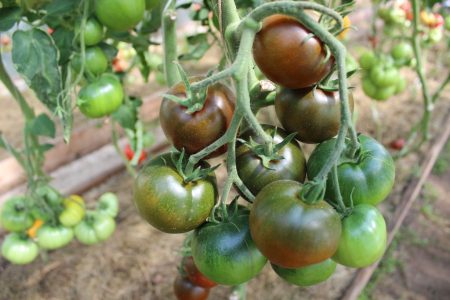
Garter, as well as the formation of a bush, is mandatory, for which it is best to use special trellises.
A plant with a large number of leaves, sprawling, so it is planted per 1 square. meter no more than three bushes. Ripening dates - about 110 days from the moment of emergence of shoots (in greenhouses). On the ridges, the dates are shifted, the first fruits are removed a little later and this must be taken into account by the gardeners of the northern regions.
Fruits are rounded, slightly flattened, with dense skin. Coloring is dark red, turning into brown and burgundy. The skin color is very beautiful, and its name - Brazilian miracle tomato confirms.
The pulp is juicy, few seeds. The taste is sweet, there is a pleasant aroma. The fruits have a universal purpose:
- for salads;
- for conservation;
- in salting;
- making pastas and sauces;
- for slicing and serving dishes.
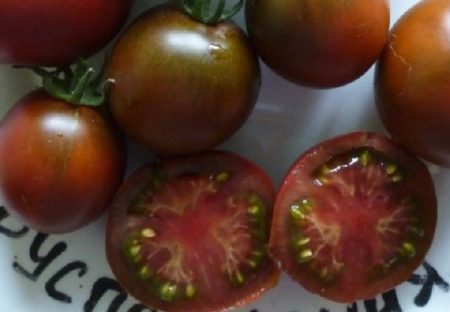
The fruits of the variety have a dense structure, do not lose shape when canned, retain their taste during long-term storage (up to two months).
Dark tomatoes look great in various dishes, so they are often used for slicing, as well as for decoration.
Advantages and disadvantages of the Brazilian Miracle variety
There are not so many “minuses” in this variety, and among them is the difficulty of acquiring a tomato. Typically, such unusual varieties are prescribed by collectors, but this must be done in advance so that the seeds are available at the beginning of the sowing for seedlings.
Also, the need to form a bush can be considered a drawback, which is not always the case with beginner gardeners. True, you can always keep the bush in one stalk, and let the yield be lower, but there will be less trouble with stepsons and removal of shoots.
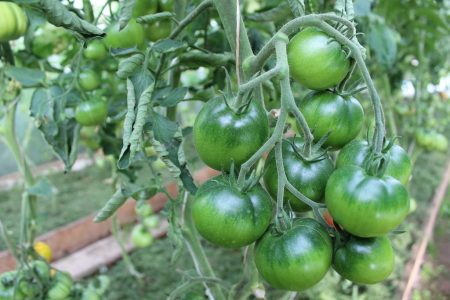
Benefits:
- good yield (up to 3-4 kg of delicious tomatoes from one bush);
- the original color of the fruit, which draws attention to the variety;
- excellent taste (this is noted by all gardeners who have had experience growing the Brazilian miracle);
- unpretentiousness;
- resistance to the main diseases of tomatoes;
- easy care.
Dark tomatoes are champions among their counterparts by the number of vitamins. By regularly eating such brown-red tomatoes, you can prevent many diseases, increase immunity, and improve vision.
The problem with seeds can be solved by procuring your own planting material, and this is also an important “plus” of the variety. Properly organizing care, you can provide your family with useful and delicious vegetables for the entire winter season.
Features agricultural technology varieties Brazilian miracle
Noting the high productivity of the Canadian variety, it must be taken into account that good results can only be achieved if all the rules of agricultural technology are observed. It all starts with preparing seeds and growing healthy seedlings.
By timing:
- sowing Brazilian miracle seeds in March is carried out, taking into account the lunar calendar for the current year and the climatic conditions of the region;
- seedlings are planted in the greenhouse when the soil warms up to + 14ºC ... + 16ºC;
- if the greenhouse is heated, then planting can be done in late April;
- Tomatoes are planted in unheated shelters not earlier than May 25, or even later, in the first days of June (it is advisable to provide additional insulation).
Famous potassium permanganate is used to disinfect seeds; growth stimulants, aloe juice, infusions of wood ash are used to improve germination.
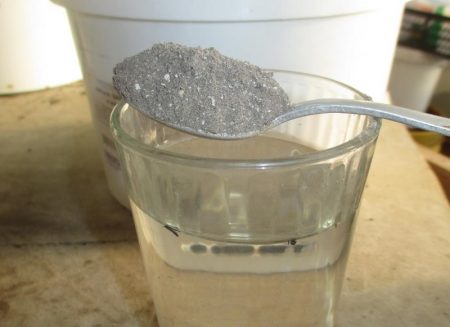
The temperature regime when growing seedlings is maintained very strictly, otherwise by the time of planting the seedlings will be elongated and frail.
- During the germination period of the seeds, the temperature is maintained in the range + 25ºC ... + 27ºC.
- After emergence for 5-7 days: + 18ºC ... + 20ºC.
- The following period for landing at a permanent place: + 22ºC ... + 24ºC.
Picking is carried out in the phase of the appearance of two true leaves, and only after this procedure, after 7-10 days, seedlings can be fed for the first time.
A mandatory procedure is the hardening of tomatoes, for which they are carried out in the open air.
Tomatoes are planted in a greenhouse strictly according to the scheme, the number of plants per 1 sq. The meter depends on the formation of the variety bushes. Usually no more than three plants are planted, leaving at least 60-70 cm between the tomatoes. Humus, vermicompost, ash, superphosphate are added to the wells, well shed. This supply of nutrients seedlings should be enough until the first feeding, which is carried out no earlier than after 18-20 days.
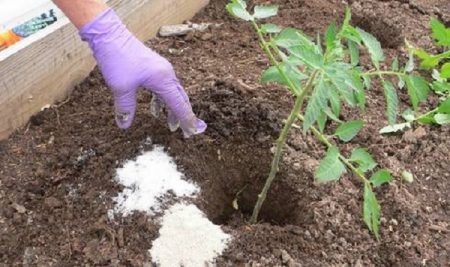
They pause for irrigation, so that the root system can form normally in plants. The first watering - after 6-8 days, not earlier.
As soon as the tomatoes adapt to the new conditions, a slight loosening can be carried out in order to provide oxygen access to the roots. At the same time, stakes are placed on the plants or the ropes of the trellis are pulled.
To improve fruit set, it is recommended to shake the plants slightly in the morning during the flowering period of tomatoes. It is very convenient to carry out this technique with a trellis method of growing, when it is enough to knock on a stretched rope or wire.
They begin to pinch approximately when the plants are 20-25 cm tall. The shoots are broken off, leaving a small "stump" up to 1.5 cm. If desired, the stepsons of the Brazilian miracle can be rooted by planting on the garden. You need to remove the shoots regularly, as in the greenhouse the plants grow very quickly. As soon as the fruits of the first brush of the bush ripen, 1-2 sheets are removed from the bottom of the stem.
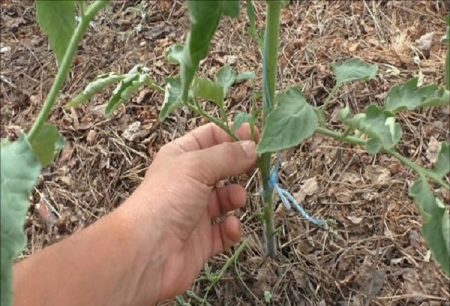
Watering is carried out every 5-6 days, taking into account weather conditions.Use only warm and well-defended water, combining watering with root top dressing. During fruiting period watered moderately, and then the volume is reduced and stopped.
Fertilizers are applied, observing the dosage, while the very first feeding should be no earlier than 16-18 days after planting the tomatoes. Then the plants are “fed” approximately every 10-12 days, alternating with spraying and applying nutritional compounds under the root.
Take into account the appearance and condition of tomatoes:
- with weak growth, thin branches, small inflorescences, nitrogen is added to the dressings;
- if there is a blue-green hue on the leaves, the appearance of wrinkling, potassium fertilizers are applied (for example, ash);
- if the leaves turn purple, there are red spots, and the stems are thin - the tomato urgently needs phosphorus.
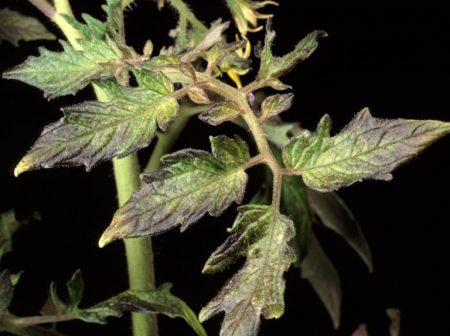
The use of complex fertilizers, as well as special compositions for tomatoes, will help to avoid deficiency of elements and provide plants with high-quality nutrition.
Tomatoes are harvested in the morning, removing both ripe and brown fruits. In the Brazilian miracle, tomatoes are ripened well at home, while at the same time, this cleaning will increase the overall yield from the bush.
To protect against various diseases, preventive measures are taken:
- spraying tomatoes with Bordeaux liquid;
- the use of ash infusion (leaf treatment), dusting of plants and soil;
- spraying with copper preparations.
Solutions of iodine and boric acid help to increase productivity. Often, many gardeners use yeast, but we must remember that this product is very nutritious and it will be enough for 1-2 seasonings per season.
Reviews about growing tomato varieties Brazilian miracle
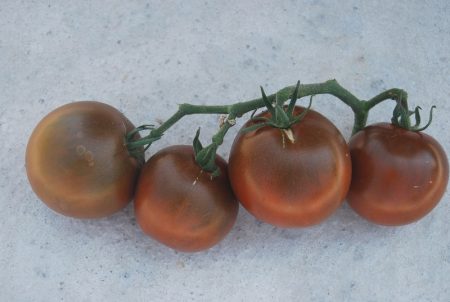
Elena, Novgorod
I always dreamed of growing black tomatoes in my greenhouse. Having written seeds from different varieties from a friend (there were three in all), she planted everything in a greenhouse. Most of all I liked the Brazilian miracle, because in addition to the yield it turned out to be also tasty. For the rest of the dark little tomatoes, the fruits did not match the declared weight, although I followed all the rules. I collected seeds from Miracle, I will now grow my own, let's see what comes of such an experiment.
Inna, Gatchina
I wrote out this sort of tomato from the collector Popenko, the seeds came early, so I was ready for sowing. Planted in a polycarbonate greenhouse, about three bushes per square meter. meter, there were six bushes. The harvest was good, all the tomatoes ripened on the bush. It was very unusual to look at such fruits, not red, but brown, as if immature. The whole family tried it for the first time, cut the first tomato into slices. The taste is very sweet, even with our sunny summer ripened and became sweet. I can imagine what their taste is like if there are sunny days all summer long. Yes, it is resistant to diseases, late blight, and last year I had it both in the garden and in the greenhouse, I was not affected.




 Low-growing tomatoes, without pinching: 5 of the most delicious varieties
Low-growing tomatoes, without pinching: 5 of the most delicious varieties Why tomato seedlings grow poorly
Why tomato seedlings grow poorly We grow a tomato in a shell
We grow a tomato in a shell Growing tomatoes without watering according to the method of Kazarin
Growing tomatoes without watering according to the method of Kazarin